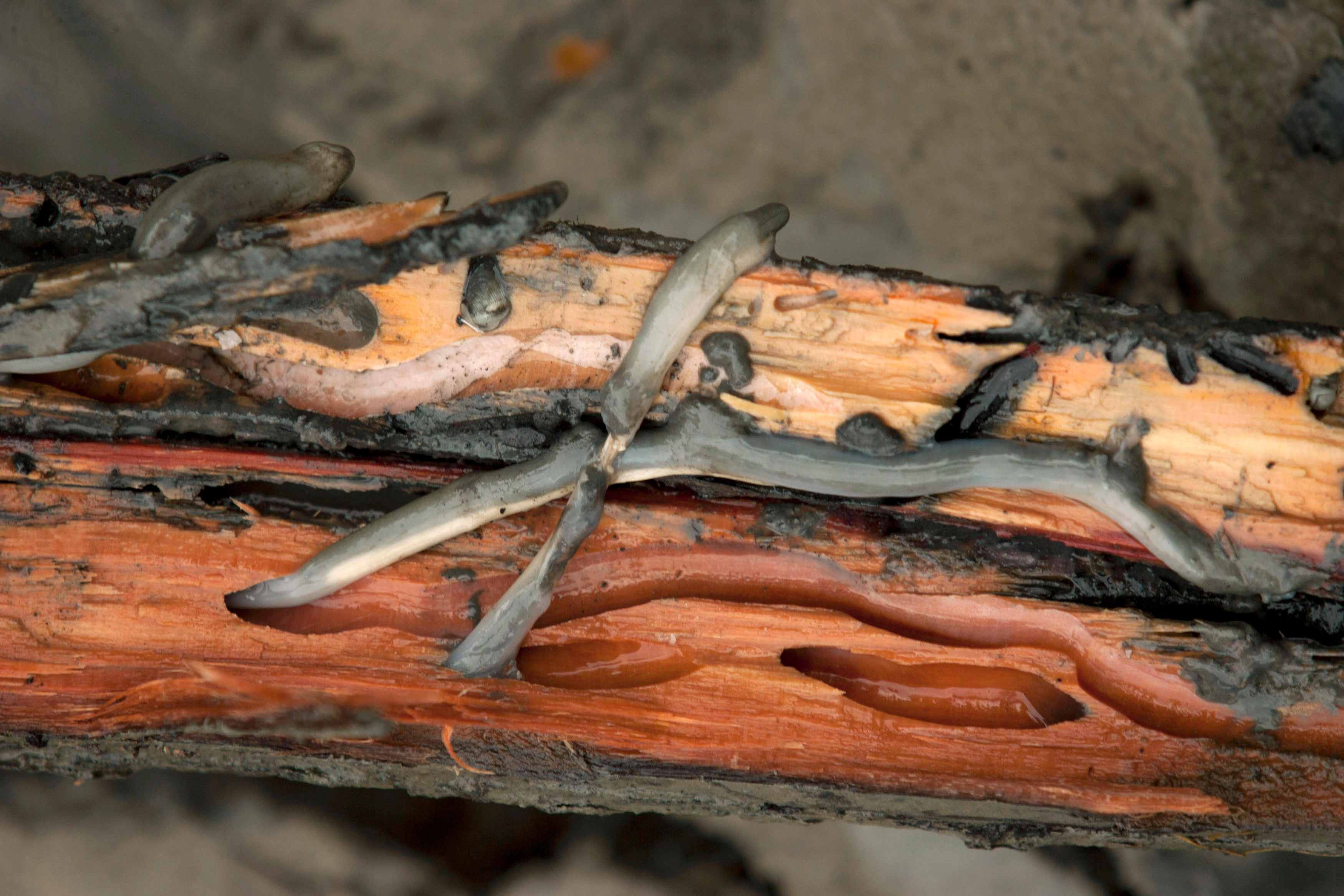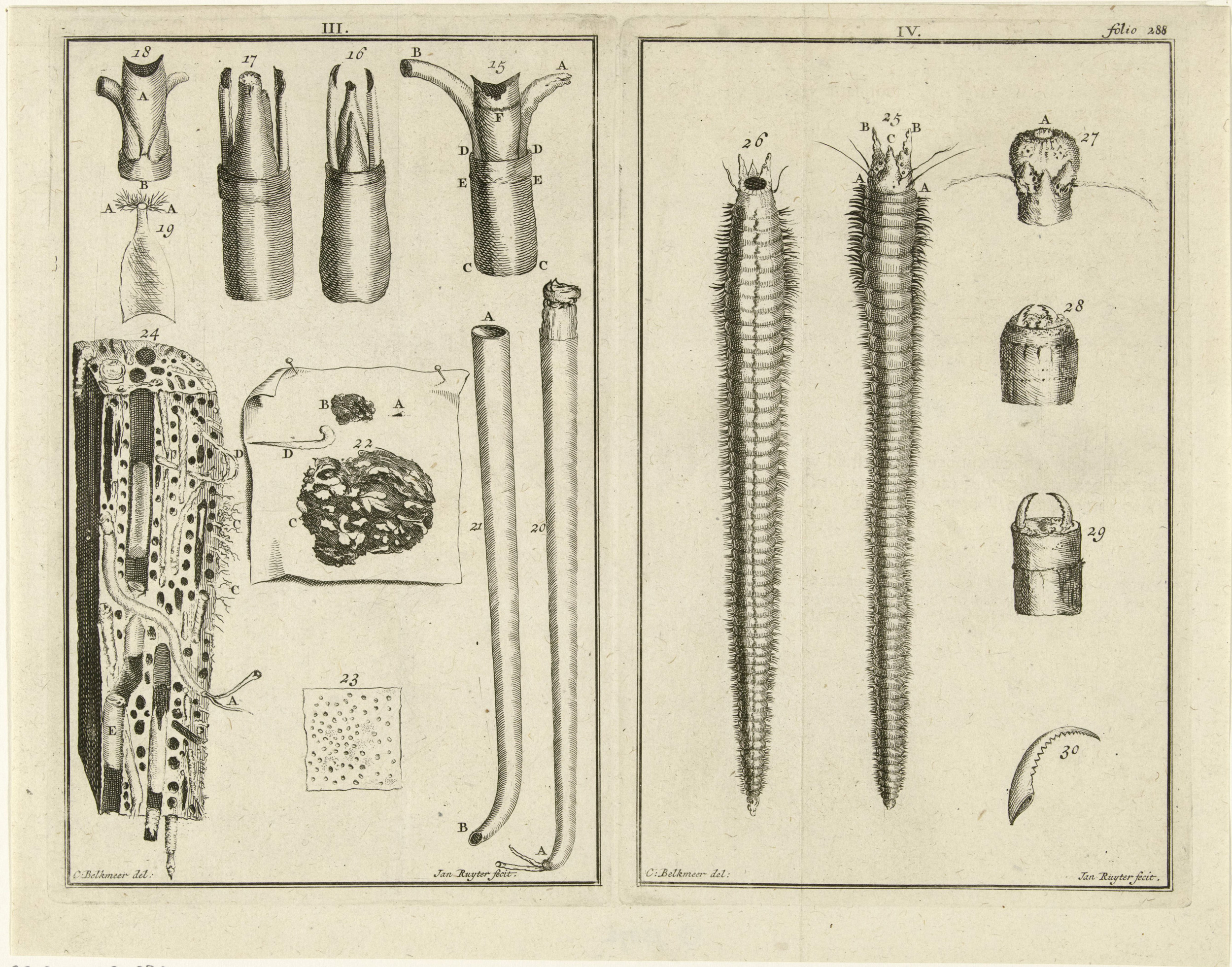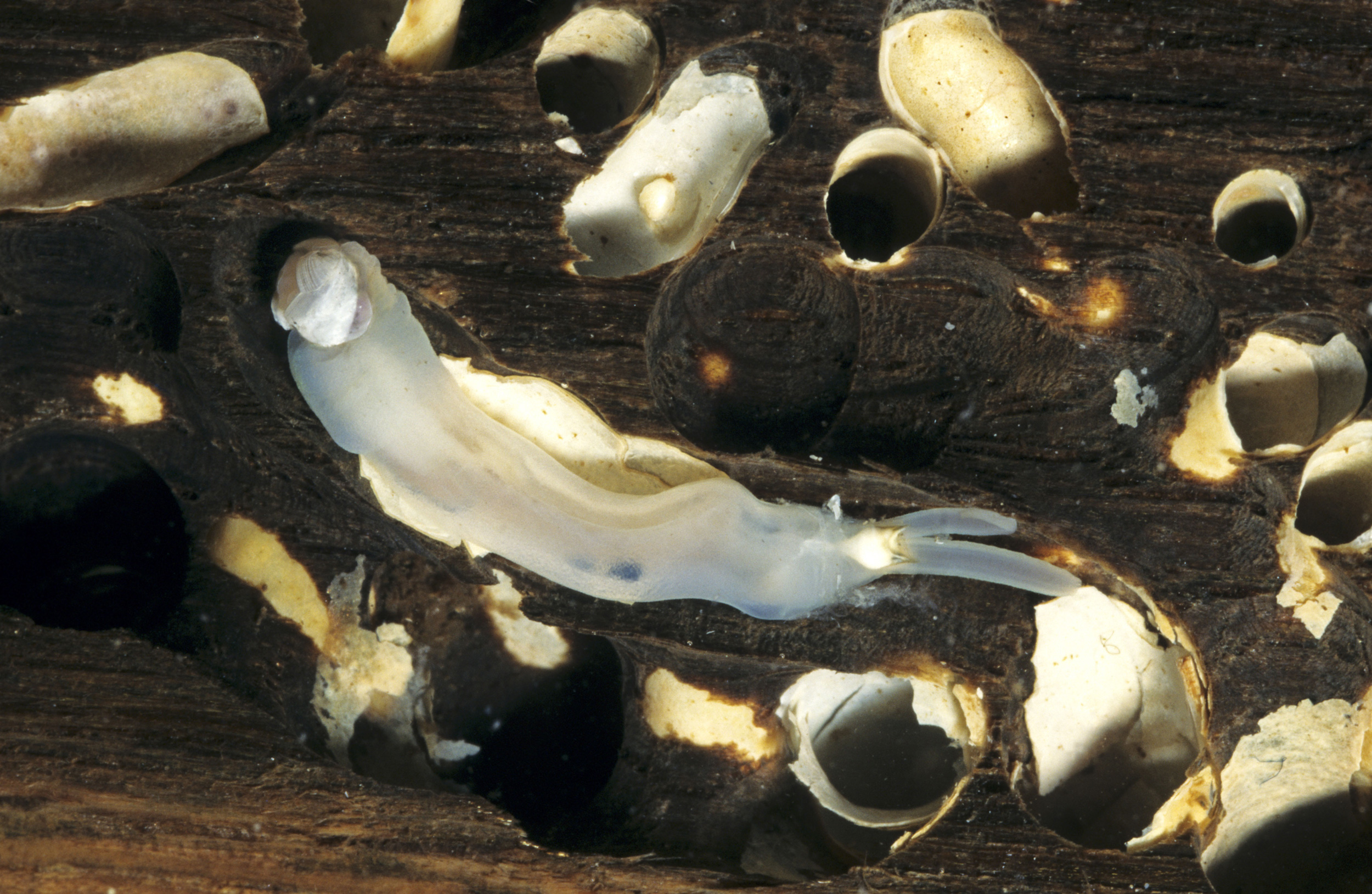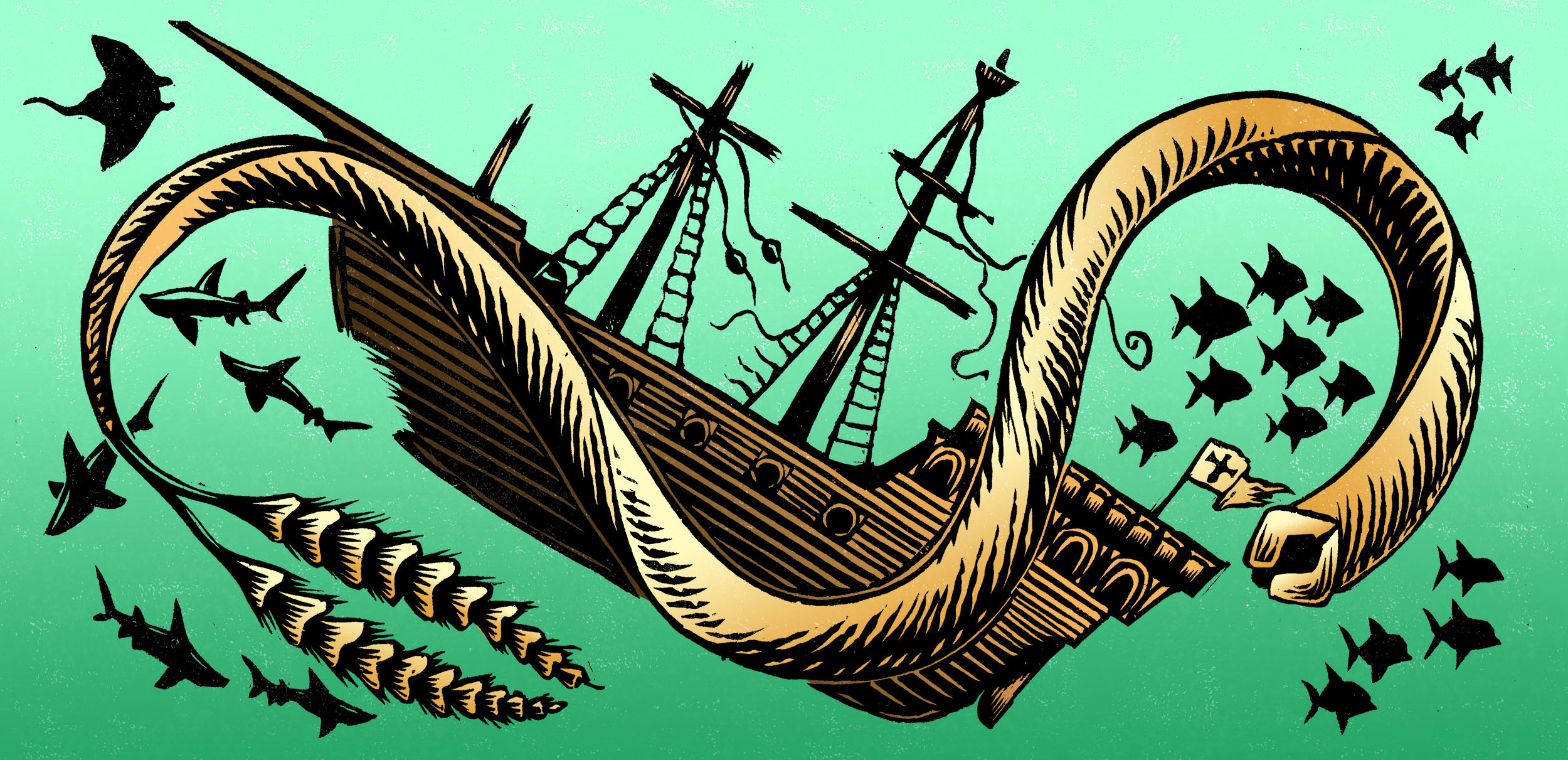The Clam That Sank a Thousand Ships
These infamous clams are invading new areas, buoyed by climate change and the 2011 tsunami in Japan.
Article body copy
The vessel, though her masts be firm,
Beneath her copper bears a worm
—Henry David Thoreau, from “Though All the Fates”
Early on a calm June morning, Nancy Treneman picks her way along the wrack line of a stretch of southwestern Oregon coast. The biologist has short, curly hair that furls in small wings from beneath her baseball cap and wears jeans patched at the knee with a denim heart. Every so often, she pauses to scrutinize a plastic bottle or lonely flip-flop, or retrieves a hatchet from her pack and skims shavings from a piece of driftwood sticking out of the bony assemblage of logs where the beach meets a steep hillside.
“The debris tells a story,” Treneman explains as she makes notes in a waterproof yellow book. “It tells you what’s going on out there. When the fishing boats are out there. When the crabbing is happening. When the hagfishing is going on.”
And today, just like 30 other days over the past three years, Treneman is looking for passages from a very particular story that may have snagged here among the rocks and sea stacks at Crook Point—a promontory inside Oregon Islands National Wildlife Refuge that happens to be a perfect catchment for Pacific Ocean castoffs. Suddenly, she spots a black plastic sphere the size of a beach ball. “Oh, oh, a new float! … This one looks freeee-esssh! Lookit! It’s got a mussel!” she cries excitedly, pointing to a delicate lacework of threads fouling its surface. “This is a tsunami float. All this stuff is old mussels.” The cluster of thumb-sized bivalves are Mytilus galloprovincialis, a Mediterranean species that has established itself along the Japanese coast.
Treneman perches on a log and punches out an email on her cellphone to marine biologist Jim Carlton, then retrieves a ziplock bag of chocolate cake from her pack and passes me a piece. “I need the bag,” she says, scraping the creatures from the float’s surface and dropping them inside.
When the magnitude 9.0 earthquake struck off the coast of Japan in 2011, it measurably shifted the country’s main island eastward, tweaked the tilt of Earth’s axis, and killed nearly 20,000 people with the towering wave that followed. The tragedy also sucked an enormous amount of buoyant stuff out to sea—fishing boats, docks, plastic flotsam—offering scientists an unprecedented look at how species raft to new environments on anthropogenic debris, a mechanism that is increasingly influencing ecosystems. With the help of volunteers, government officials, and funders, Carlton, Treneman, and more than 50 other taxonomists have identified about 300 different species that survived a journey of thousands of kilometers across the ocean to Hawai‘i, California, Oregon, Washington, British Columbia, and Alaska.
Among them is the little-known mollusk closest to Treneman’s heart: not the Mytilus, no, but the shipworm, a tunneling bivalve with a voracious appetite for wood. Though we don’t find any on this day, about 22 percent of the tsunami debris that researchers have assembled from the North American west coast is wooden building material. And as Treneman has painstakingly examined 125 collected pieces, she’s found them riddled with shipworms from Japan’s coastal waters and from the open ocean.

Shipworms may resemble worms, but they are actually a type of mollusk. A chalky tube, seen in the lower image, is secreted to protect the body. Photo by Nature Photographers Ltd/Alamy Stock Photo
It’s too soon to tell whether any of the species will make a home alongside the one native and handful of introduced shipworm species here, says Carlton, a pioneer in the study of invasive marine organisms. But if they do, it will be the latest chapter in a tale of shipworms and people that stretches back millennia. Since some of the earliest recorded references to the creatures appeared in texts from ancient Greece, the clams have hitched rides in the hulls of wooden boats and, later, in ballast water, settling in ports and harbors around the globe and devastating wooden infrastructure as they went. In fact, some species have become so ubiquitous, they’re cryptogenic—meaning it’s impossible to tell where they originated. Theirs, perhaps, is a liminal eighth continent, one built not of land, but of motion itself, its boundaries defined in part by the human quest for empire and commerce.
And these days, traveling shipworms may find that people have altered the ocean conditions in their favor with global climate change. “It’s hard to make confident predictions given the roulette nature of who moves where and when, but I’m pretty comfortable with the shipworm story,” Carlton says. “Harbor and port managers who still have wooden pilings in the water would be well advised to recognize that the age of shipworms is rising again.” Or, to be more precise, that it never ended at all.
It’s easy to see why early naturalists classified members of the family Teredinidae as worms instead of clams. They possess ropy, translucent bodies that, depending on species and environment, may grow longer than a meter. The valves of their shells perch atop their heads like tiny helmets and bristle with rows of tooth-like protrusions. These allow shipworm larvae to drill into the surface of submerged wood, then burrow along the grain as they grow, funneling the shavings into their mouths, and turning wood into both a protective shell and a meal.
Digesting wood’s complex structure isn’t easy, explains Dan Distel, a research professor at Boston’s Northeastern University who focuses on shipworm symbioses. So shipworms “essentially farm bacteria inside their [gill] cells,” which in turn furnish wood-busting enzymes. The clams’ microbial green thumb has earned them the distinction of being one of the ocean’s primary recyclers of wood, a process that provides a cascade of important ecosystem services, Distel says, not least among them is “taking a resource that fish can’t eat, and turning it into larvae, which is something that fish can eat.” One particularly fecund shipworm species releases 100 million eggs in a single spawning event.
Little of this activity, though, is visible. That first borehole remains small; the only sign that it’s occupied is a pair of occasionally protruding siphons. These paired tubes, one incurrent and one excurrent, allow the shipworm to supplement its diet with plankton filtered from the water, as well as breathe, breed and excrete, all while hollowing out the wood.
It wasn’t until the most notorious and widespread of the shipworm species, Teredo navalis, Swiss-cheesed the wooden piles that guarded the Netherlands’ earthen dikes from ocean incursions in the 1730s, that an academic by the name of Gottfried Sellius correctly identified them as mollusks. By that time, the same traits that make them ecologically crucial had also earned them a prominent place in maritime history. In 1503, shipworms honeycombed the vessels Christopher Columbus brought on his fourth voyage, sinking at least two of them. In 1588, teredo, as they are often called colloquially, played a role in Britain’s defeat of the Spanish Armada, weakening the timbers of the Spaniards’ superior fleet and making it more vulnerable to storms and cannonballs. Later, they may have compromised the hull of the Nantucket whaling ship Essex—allowing easier penetration by the bull sperm whale that rammed the boat in 1821, and inspired the literary classic Moby Dick. One paper even claims shipworms sank more ships than pirates. “This,” says mostly retired marine biologist Kevin Eckelbarger, who plans to write a book on shipworm history, “is an animal that Captain Cook feared as much as the [Hawai‘ians] who probably killed him.”

Shipworms move through their boreholes in a mangrove trunk at the mouth of the Amazon River in Brazil. Residents of the region eat this mollusk raw. Photo by Reuters/Alamy Stock Photo
The Dutch, for their part, soon girded their dikes with expensive imported stone instead of wood. But not before certain religious institutions declared official “thanks, fasting and prayer” days in hopes of warding off this new divine “plague,” and not before Sellius cataloged some 500 to 600 methods of preventing shipworm invasion, according to the Nautical Magazine for 1878, “some of which are more amusing than practicable,” including, for ships, “an inner layer of calf skins, cow hair, pounded glass, ashes, glue, chalk, moss, or charcoal.”
In the United States, hopeful inventors had submitted 1,000 shipworm deterrents to the US patent office by the end of the 1800s. Canadian logging companies detonated dynamite in the water to create a pressure wave that killed shipworms inside floating logs. Chemical concoctions such as the carcinogenic biocide creosote came into widespread use, often polluting waterways. Mariners scoured the world for naturally repellent wood, contributing to deforestation, particularly in the tropics. “Once a species was rumored to have resistance, faraway stands of those trees, many in Australia and New Zealand, fell victim to teredo by proxy,” writes historian Derek Lee Nelson, a PhD candidate at the University of New Hampshire. “[US] domestic forests also suffered; the reputation that North Carolina yellow pine garnered for resisting teredo … helped to make the tree commercially unavailable by the end of the 1910s.”
Few of these defensive tactics did much more than postpone invasion, so people also went on the geographic offensive, according to Nelson, making the shipworm their unwitting coauthor as they reshaped North American coastlines. Because many shipworms—including Bankia setacea, the species native to the continent’s west coast—require high salinity to thrive and breed, estuaries and river mouths can shield wooden ships and marine structures from damage. Natural freshwater ports were quickly developed, while some saltwater ports were altered to increase freshwater circulation. In Seattle’s Puget Sound, for example, the US Army Corps of Engineers authorized the dredging of the Snohomish River and the construction of a new jetty in the ocean near its mouth in 1890 to concentrate the river’s flow into a protective pocket.
In 1919, though, even fresh water failed to do the trick in San Francisco Bay. After low-salinity tolerant Teredo navalis appeared there, coincident with a drought that allowed saltier water to push farther inland, the species exploded in what would become one of the most expensive outbreaks in recorded shipworm history—wharves, piers, and ferry slips crumbled at an average rate of one every two weeks for two years. Other ports, like New York Harbor, the Hudson River, and Los Angeles Harbor, which had been “protected” by industrial pollution, experienced devastating resurgences of shipworms and wood-boring isopods known, rather charmingly, as gribbles, after cleanup efforts like those required by the United States’ 1972 Clean Water Act.

In the Netherlands, dike inspectors discovered a “worm” in the wooden breakers after a storm in 1730. This print shows workers removing the wood from the dike. The shipworms in the foreground are, obviously, not to scale but an exaggerated rendition. Image courtesy of Rijks Museum
The side effects of these kinds of dramatic, if submerged, clashes were leaps forward in the understanding of wood-borers’ biology, as well as many other facets of the marine world. The US Navy and others poured buckets of money into research led by individuals such as Ruth Dixon Turner, a curator and professor at Harvard. Known affectionately among some mollusk nerds as the goddess of shipworms, in 1971, Turner became the first woman to visit the deep sea in the submersible Alvin. She also wrote the still-definitive catalog of shipworms—perusing museum collections around the world to winnow more than 300 suspected species down to around 70.
But the struggle between man and clam forced many countries to go the way of the Dutch and build with shipworm-resistant materials, and the public attention and research blitz waned. Steel and fiberglass largely replaced wood in ship and boat hulls early on. As creosote and certain wood pressure treatments fell out of favor or were restricted by some governments for their health and ecosystem impacts, the wood in marine structures has gradually been replaced or reinforced with much more expensive and durable materials such as concrete, fiberglass, and metal. Even though shipworms still cause an estimated US $1-billion in damages worldwide annually, by the time Turner died in 2000, the mollusks had retreated into relative obscurity.
Though interest is climbing again, Northeastern University’s Dan Distel says, “When I started [studying shipworms around 1989], I remember one day I was at a meeting and I decided to go out to lunch with a few friends.” As they crossed the street, “one commented that if a bus ran us over right now, it would wipe out everyone doing shipworm research in the world.”
Nancy Treneman’s home tsunami debris “lab” is a shed with a deck overlooking forest and sea above Gold Beach, Oregon. Wood chunks and beams, some wrapped in garbage bags, line the floor and sawhorse tables. The one she selects today is a round of Douglas fir—possibly exported by ship from the Pacific Northwest to Japan before being swept back to Oysterville, Washington. She balances it carefully inside a cardboard box, turning it this way and that to find tiny entrance holes in its sides. Then, she uses a hatchet to split it along the grain, following the now-empty tunnels—lined with eggshell-thin calcium carbonate—so she can measure their length and width. After each split, Treneman examines the severed chunks for remains, then whacks them with a hammer. Occasionally, shells fall out, or tiny spatula-shaped structures called pallets, which shipworms fold together like praying hands to seal off their burrows. Pallets are key to identifying species and go into vials filled with an ethanol solution made from Everclear, a 190-proof grain alcohol, for later identification. It takes hours to process a single log, but if the tedium has scared others away from the field, it clearly doesn’t bother Treneman, who leans into every discovery.
She’s a newcomer to shipworm taxonomy, but her dogged enthusiasm has earned her a clear expertise, hard-won through studying Turner’s catalogs, collaborating with other scientists, and making her own museum pilgrimages. A high school science teacher for 30 years, Treneman, who has a master’s degree in genetics, returned to old ambitions to become a research biologist after moving to Gold Beach. It was an easy drive from there to classes and projects at the Oregon Institute of Marine Biology to the north in Charleston, where she reconnected with her old college professor Jim Carlton, who has long taught summer courses there. Her retirement in 2013 serendipitously coincided with the arrival of tsunami debris on the North American west coast, and she seized the opportunity to work with Carlton on the shipworm side of the project. When she had processed enough wood to gather a collection of parts, she asked him how to identify them. “Ruth Turner is dead and nobody followed in her footsteps,” she recalls him telling her. “You might have to send them to Australia.” But Treneman was determined. “I thought, ‘No!’” she says. “I spent hours and hours collecting this stuff. How hard can this be?”
Turning back to her task, she points out a tunnel that branches wildly at a little knot. “Look at this one here. This is great,” she says. “He came down here, tried this, stopped. Tried this, stopped. Or this, stopped. He went three different directions. … But then,” she pauses matter-of-factly, “he died.”

Dutch printmakers made various etchings of shipworms and the damage they did, including this one (left page) dated to between 1726 and 1744. The mollusks’ presence on the Dutch coast changed how the country built their dikes, sluices, and harbors. Image courtesy of Rijks Museum
The species we’re following through the wood now is big, with a tunnel as thick as my index finger—“the kind of shipworm,” Carlton tells me later, “that you don’t want to meet in a dark alley at night.” It also appears to be a species that tolerates colder water, which means it could find a home on this side of the Pacific. “We do still have a lot of wood in the water. So it wouldn’t be good if we gained another wood-boring organism,” he says. Even if the Japanese species don’t establish, though, more warm-water tropical and subtropical species are likely to move inexorably toward the poles as ocean temperatures rise. Called “Caribbean creep” on the US East Coast, this phenomenon has been widely documented in many species, everywhere except places in the developing world where few people are looking. Meanwhile, river flows are expected to decline in some places as droughts and dry, warm weather become more frequent, and sea level is expected to rise, all of which could increase the penetration of salt water into river mouths, and endanger wooden infrastructure that has remained protected by freshwater inputs.
With shipworms, “the main concern you have to have about global warming is that it’s going to increase their distribution and range, increase the animals’ activity and extend the window of time in which they can reproduce,” since they tend to breed and establish on wood during warmer seasons, says Reuben Shipway, another collaborator on Carlton and Treneman’s tsunami research who works with Distel at Northeastern University.
There is some evidence that this is beginning to occur. Off the Swedish coast, scientists have found evidence that Teredo navalis larvae are actively invading submerged wooden panels 26 days later into the fall on average than they were in the 1970s, a trend that correlates strongly with higher sea-surface temperatures.
Such changes could similarly boost potentially more destructive tropical species that hitchhike to new places in ballast water and by other means. In 2010, Shipway was called to the Uluburun III, a replica of a 3,300-year-old shipwreck discovered off the coast of Turkey, which had contained trade goods from seven different cultures, including cobalt blue ingots of glass, and an ivory and gold scarab emblazoned with the cartouche of Nefertiti. The new vessel had been dropped to the ocean floor in 2006 for diving tourists. Less than two years in, it was visibly infested with shipworms and gribbles, and by the time Shipway dove to the wreck, he was able to break off pieces with his hands. “When I came back the second summer,” Shipway says, “it was literally just the mast left, surrounded by piles and piles of calcareous tubes.”
The primary culprit, Shipway discovered, was Teredothyra dominicensis—a shipworm species discovered in Dominica and previously thought to live exclusively in the Gulf of Mexico and Caribbean Sea. The creatures were rapidly infesting the wooden panels Shipway had planted at the wreck site in the Mediterranean, suggesting they were well established there, too. Combined with documented increases in local sea temperature and salinity, this doesn’t bode well for Mediterranean cities such as Venice, Italy, which still has loads of wooden pilings and other structures in the water, and plenty of problems with the resident shipworm and gribble species. Already, “the frequency of maintenance is reported to be higher,” says Davide Tagliapietra, a biologist at the Institute of Marine Science in Venice, though it’s difficult to untangle the exact causes.

Teredo navalis is the most common and infamous shipworm. Responsible for taking down at least two of Christopher Columbus’s vessels in 1503, the species has a special place in maritime history. Photo by blickwinkel/Alamy Stock Photo
Luisa Borges, a Portuguese gribble and shipworm researcher based in Germany who is working closely with Treneman and Shipway on the tsunami debris, has also documented range shifts. Her surveys of European waters revealed that a species called Lyrodus pedicillatus has become dominant in some areas where historical data suggests it had occurred only sparsely, partially displacing the old scourge Teredo navalis in Portugal’s Tagus estuary and as far north as the English Channel. Increases in salinity and temperature, combined with a difference in breeding strategy, likely conferred the newcomer an advantage—though Borges, like Tagliapietra, is careful to note that more research is needed to confirm a trend. It would be worth finding out, given that the United Kingdom, Scandinavia, and Germany all still have a lot of wooden marine infrastructure, Borges says. In a warmer, saltier future, “What we don’t want is for shipworms to do something like they did in the 18th century in the Netherlands.”
For all the damage shipworms have caused through the ages, many of the biologists who study and celebrate the wily mollusks seem eager to have a different conversation about their relevance to civilization. After all, the cavities shipworms make become homes and hiding places for creatures like crabs, octopuses, and polychaetes. And with so much coastal infrastructure now fortified, our relationship with shipworms could also be one of connection instead of war. Beyond the simple wonder that something of their kind exists at all, there is the fact that people still eat shipworms in Southeast Asia, Australia, Brazil, and other countries. Distel and Shipway believe shipworms’ enzymes may offer breakthroughs for creating biofuels from wood wastes, and others are studying the antibiotics that help shipworms maintain only certain bacteria in their gills, which may offer treatments for human diseases. Yet people are rapidly destroying the tropical and subtropical habitats where the mollusks originally evolved and still thrive—mangrove swamps that are also vital carbon sinks that could help moderate the effects of global warming. And dams and waterfront development have likely decreased the amount of natural woody debris that washes into the ocean, altering available habitat not just for shipworms, but also for a whole suite of species.
“As shipworms eat their wood, they’re also destroying their home,” Nancy Treneman observes as we pause for coffee in her sunny office. “They essentially kill themselves off. It’s kind of a great microcosm of our own situation as humans. Here we are on a planet, eating ourselves out of house and home.” But there’s one key difference: shipworms simply release an overwhelming horde of larvae—tiny ships that will carry their DNA to new wooden worlds where they can do it all again.

